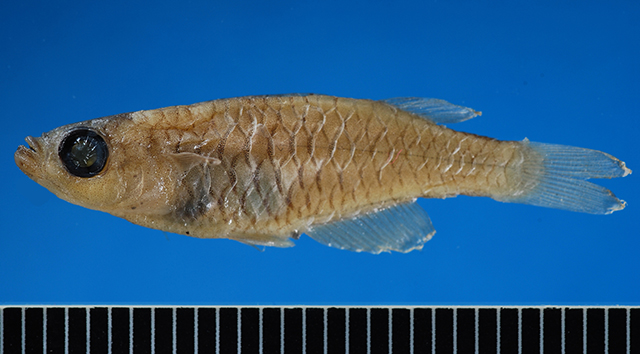|
Dorsal spines (total): 0-0; Dorsal soft rays (total): 9-11; Anal spines: 0-0; Anal soft rays: 17-18; Vertebrae: 29-30. Diagnosis: Hylopanchax paucisquamatus is distinguished from all other known Hylopanchax species by a unique combination of morphological characters; by body-shape, it belongs to the group of more deep-bodied species in the genus (Ref. 96960). From the small, very slender H. moke it is distinguished by a deeper body, 26.1-27.2% of standard length vs. 16.3-20.2%; larger size, 22.0-26.1 mm standard length vs. 21.2 mm; a longer head, 26.7-29.6% of standard length vs. 17.9-23.7%; a deeper caudal peduncle, 11.8-12.2% of standard length vs. 7.7-11.3%; a longer dorsal-fin base, 11.7-13.1% of standard length vs. 5.9-9.9%; a lower number of mid-longitudinal scales, 19-21 vs. 23-26; a higher number of dorsal-fin rays, 9-11 vs. 6-7; and insertion of dorsal-fin above anal-fin ray 8 or 9 vs. 11-14 (Ref. 96960). From the slender H. stictopleuron and H. silvestris it is distinguished by a deeper body, 26.1-27.2% of standard length vs. 20.8-21.0% or 22.2-26.3% respectively; a slightly higher number of dorsal-fin rays, 9-11 vs. 6-8; a more anterior origin of dorsal-fin in relation to anal-fin, dorsal above anal-fin ray 8 or 9 vs. 12 or 13; and a lower number of mid-longitudinal scales, 19-21 vs. 24-25 (Ref. 96960). Hylopanchax paucisquamatus is distinguished from the two described deep-bodied species H. leki and H. ndeko by a longer predorsal distance, 68.8-70.7% of standard length vs. 61.0-67.8%; a narrower caudal peduncle and higher caudal peduncle ratio, 11.8-12.2% of standard length and 1.8-1.9 vs. 12.2-15.5% and 1.2-1.7; a shorter dorsal-fin base, 11.7-13.1% of standard length vs. 15.6-22.2%; a lower number of transverse scales, 15-16 vs. 18-22; a slightly lower number of dorsal-fin rays, 9-11 vs. 11-14; and a lower to slightly lower number of mid-longitudinal scales, 19-21 vs. 24-26 for H. ndeko and 21-23 for H. leki (Ref. 96960). It can also be distinguished from H. leki by a less deep body, 26.1-27.2% of standard length vs. 29.2-35.5%; and from H. ndeko by a longer caudal peduncle, 21.8-23.0% of standard length vs. 16.5-20.8% (Ref. 96960).
Description: A relatively deep-bodied Hylopanchax species, laterally strongly compressed; dorsal profile convex, greatest body depth approximately at pelvic-fin base; ventral profile convex from snout to end of anal-fin, concave on ventral caudal peduncle (Ref. 96960). Snout rounded, mouth directed upwards, lower jaw longer than upper jaw; outer row of larger and slightly curved conical teeth on both jaws, inner row with smaller and more irregularly arranged teeth, symphysis forming ridge on lower and upper jaw, branchiostegal appendages present in adult males (Ref. 96960). Frontal or nasal neuromast system absent, one pre-orbital neuromast in short, shallow open groove; post-orbital and supra-orbital neuromast system provided with large neuromasts and large lobes, covering a great part of the groove; pre-opercular neuromast system with 5 pores (Ref. 96960). Total number of vertebrae 29 or 30; hypurals fused into one large plate, 8 or 9 caudal-fin rays attached to hypural plate, posterior neural and hemal spines flattened (Ref. 96960). Scales cycloid, body completely scaled except ventral head surface, 1 or 2 rows of scales underneath eye, frontal head squamation of G-type, no scales on dorsal- and anal-fin base, scales on mid-longitudinal series 19-21, 3-4 scales posterior to hypural plate on caudal-fin base (Ref. 96960). Number of dorsal-fin rays 9-11, anal fin rays 17-18, caudal-fin rays 25-26, pectoral-fin rays 12-13; first dorsal-fin ray above anal-fin ray 8 or 9 (Ref. 96960).
Colouration: Preserved specimens brownish, darker on head, lighter ventrally; body covered with small melanophores, denser on dorsal and lateral scales, less dense on ventral (Ref. 96960). Fins translucent, paired fins brownish, dorsal with dark spots; faint narrow dark band present at base of anal-fin, crescent-shaped markings on flank scales, darker and broader on anterior large scales, urogenital papilla dark in males and ringed with dark pigmentation in females (Ref. 96960). Colouration of this species in life currently not known (Ref. 96960). |

